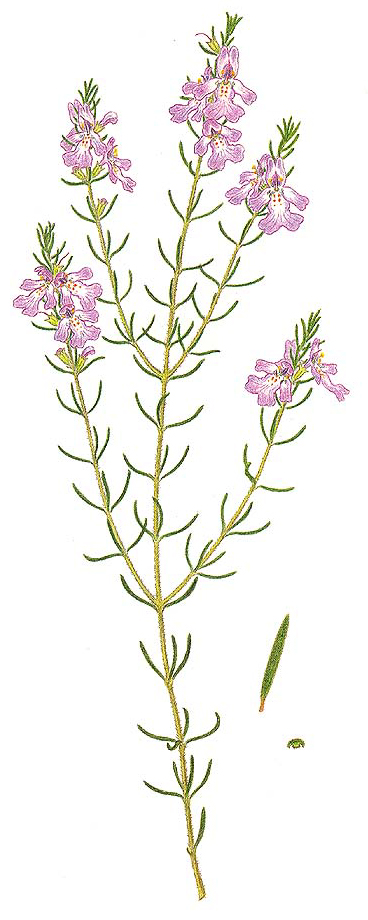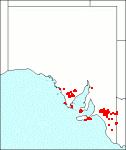Family: Lamiaceae
Westringia eremicola
Citation:
Cunn. ex Benth., Labiat. gen. spec. 459 (1834).
Synonymy: W. angustifolia sensu J. Black, Fl. S. Aust. 494 (1926), non R. Br. (1810).
, Westringia grevillina Common name: Slender westringia, slender western rosemary.
Description:
Shrubs 0.3-1.5 rarely to 2 m high; branches triangular or quadrangular to subterete, moderately to densely hairy; leaves in whorls of 3 or rarely 4, spreading and usually slightly recurved; petioles 0.5-0.7 mm long, densely hairy; lamina narrowly elliptic to linear, 6-12 rarely 4-15 x 0.6-1.3 mm, moderately to densely hairy, often only with hair bases persistent on mature leaves (hence appearing glabrous), the abaxial surface densely hairy along the midrib, base obtuse or lamina not restricted at the base, margin entire and recurved, often with the abaxial surface almost concealed, apex submucronate with a mucro to c. 0.3 mm long; pedicel 0.6-1.2 rarely to 1.7 mm long, to 2 mm long in fruit, densely hairy.
Bracteoles inserted near the base of the calyx, narrowly ovate to linear, 1-2.6 mm long, 0.2-0.5 mm wide, moderately to densely hairy; calyx green, mid-vein and marginal veins of sepals slightly thickened to form ridges on the calyx tube, outer surface densely hairy, hairs 0.3-0.4 mm long; tube 2.5-4 rarely to 4.5 mm long, inner surface glabrous at the base, moderately to densely glandular (glands stalked) on part surrounding the ovary, glabrous in the mouth, or glabrous throughout; lobes triangular, usually appearing narrowly triangular because the margin is strongly recurved, 1.3-3 rarely 1-5.3 mm long, 1-2 mm wide, inner surface densely hairy; calyx lobe to tube ratio 0.4-0.6 rarely 0.3-0.9; corolla 6.5-8.5 mm long, lilac, mauve or purple, rarely white, with orange to brown dots medially on the lower surface of the tube and mouth, dots also on lateral and lower lobes, or dots apparently absent; outer surface glabrous basally, sparsely to moderately hairy on the distal part of the tube, densely hairy on lobes, hairs 0.1-0.4 mm long; inner surface densely hairy in the throat, sparsely hairy on basal part of lobes, lobes often glabrous distally, hairs 0.2-0.4 mm long; tube 5-6.5 mm long; lower median lobe oblong to obovate, 2.9-3.9 mm long, 2.9-3.3 mm wide; lateral lobes oblong to slightly obovate, 2.9-3.3 mm long, 1.6-2 mm wide; upper median lobe-pair 2.6-3.8 mm long, 2.6-3.9 mm wide; staminal filaments 1.3-2 mm long, glabrous; anthers 0.7-1.3 mm long; staminodal filaments 0.5-1.3 mm long, sparsely hairy (particularly at the base); sterile anther lobes 0.6-0.8 mm long; pistil 7-8 mm long; ovary 0.7-1 mm long; style 6.5-7 mm long; stigma lobes c. 0.4 mm long.
Mericarps 1.3-1.5 mm long.

| Flowering branch.
|
Image source: fig. 558H in Jessop J.P. & Toelken H.R. (Ed.) 1986. Flora of South Australia (4th edn).
|
Published illustration:
Burbidge & Gray (1970) Flora of the A.C.T., fig. 318.
|
|
Distribution:
|
Usually occurring in sandy soils (rarely in clays), overlying or derived from sandstones, shales or granitic rocks, in mallee-eucalypt communities with an understorey typically of Leptospermum sp., Calytrix tetragona, Acacia ssp., Daviesia spp., Leucopogon spp., Triodia sp., etc.
S.Aust.: EP, NL, MU, YP, KI, SE. ?Qld; N.S.W.; Vic.
|
Conservation status:
native
Flowering time: Aug. — Nov.
|

SA Distribution Map based
on current data relating to
specimens held in the
State Herbarium of South Australia
|
Biology:
No text
Author:
Not yet available
|

